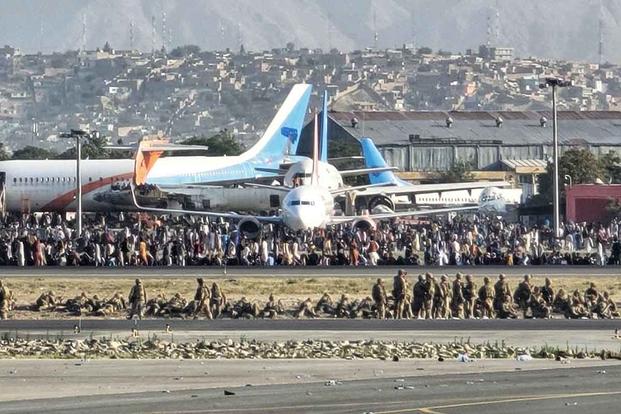

Warnings from U.S. military officers about the Taliban’s swift advances as American troops withdrew from Afghanistan in 2021 went unheeded in Washington, D.C., a disconnect that contributed to a lack of planning for evacuating civilians, House Republicans found in an investigation on the Afghanistan withdrawal being released Monday.
The report, the culmination of a two-year probe into the withdrawal that cites testimony from public hearings, closed-door interviews with witnesses, newly obtained State Department documents, previously released military documents and previous news reports, largely faults the White House National Security Council and State Department for having a rosy outlook on the situation and resisting calls from military officials to plan for an evacuation amid dire warnings from military leaders on the ground about rapidly deteriorating conditions.
That failure to plan, the report argues, led to the chaos during the eventual evacuation that allowed for a terrorist to set off a suicide bomb outside Hamid Karzai International Airport, killing 13 U.S. service members.
“The concern that a NEO equated to failure was a consistent theme in the administration’s approach to the Afghanistan withdrawal. As a result, some in the administration — especially leaders within the NSC and the State Department — were loath to plan for one,” the report from the GOP-led House Foreign Affairs Committee said, using the acronym for a noncombatant evacuation operation.
The report does not upend what’s known about the withdrawal and the failures surrounding it, but it provides a comprehensive public accounting of the events leading up to and during the conclusion of America’s longest war.
In a briefing with reporters Friday, committee staffers, speaking on condition of anonymity under ground rules set by the committee, acknowledged that other investigations have previously probed the withdrawal, but said their goal was to provide a holistic look at what went wrong.
The National Security Council did not respond to a request for comment on the report by Military.com’s deadline. But Biden administration officials have previously vigorously defended their actions during the withdrawal, arguing they were boxed in by the Trump administration’s withdrawal deal with the Taliban and that the evacuation can be considered a success since more than 120,000 people were airlifted out.
“Ultimately, President Biden refused to send another generation of Americans to fight a war that should have ended for the United States long ago,” the White House wrote last year in a summary of the administration’s own after-action reviews into the withdrawal.
The House Foreign Affairs Committee, led by Chairman Mike McCaul, R-Texas, launched its investigation into the withdrawal after Republicans took over the House majority in early 2023.
It was part of a series of investigations Republicans launched into President Joe Biden that could have hurt him politically as he, at the time, sought reelection. Republicans have viewed the Afghanistan withdrawal as a particularly potent attack line since the chaos received bipartisan criticism at the time and Biden’s approval rating first went underwater in the aftermath of the withdrawal.
Since Biden bowed out of the presidential race, Republicans have sought to tie his replacement in the election, Vice President Kamala Harris, more closely to the withdrawal. The House Foreign Affairs report includes a passage on Harris’ support for the withdrawal that largely cites an article last month from The Washington Post. And it refers to the administration as the “Biden-Harris administration,” which a staffer said was done because the administration refers to itself that way.
The report is also being released a day before Harris’ debate against Republican presidential nominee former President Donald Trump and shortly before mail-in ballots will start to be sent out in some swing states.
The narrative of the report paints a picture of a U.S. military often at odds with other administration officials, noting recommendations from Defense Secretary Lloyd Austin, then-Chairman of the Joint Chiefs of Staff Gen. Mark Milley and other military officers to keep at least 2,500 U.S. troops in Afghanistan. It also refutes the argument that those troops would have been at renewed risk by attack from the Taliban, which had halted attacks against U.S. troops after the withdrawal agreement, saying Milley advised Biden that “Afghan security forces were now conducting on-the-ground fighting, with U.S. forces largely operating within secure military bases.”
The decision to keep the U.S. Embassy in Kabul open even after the U.S. military withdrawal was also “a friction point” between the Pentagon and State Department, according to the report.
Military officials “assessed that the more people who remained at the embassy and, more broadly, in Kabul, the more people the military would have to evacuate in a crisis situation,” the report said. Gen. Scott Miller, the final commander of the U.S. mission in Afghanistan, also told the committee that the State Department had “a lack of understanding of the risk” in Afghanistan.
As U.S. military forces withdrew, the Taliban began sweeping through and claiming control of dozens of districts. U.S. military leaders on the ground such as Miller issued dire warnings about the situation.
“It was clear to me that, you know, this was happening, and I was trying to get people to understand this tidal wave that was happening,” Miller told the committee.
While U.S. military forces started planning for a NEO in mid-May, the State Department and National Security Council did not begin planning for an evacuation in earnest until about a week before the Afghan government collapsed, the report said. The Defense Department’s criteria for an evacuation had been hit months prior, but the State Department, the agency responsible for ordering an evacuation, came up with its own criteria, according to the committee.
Ultimately, the State Department did not order the evacuation until Aug. 16, the day after Kabul fell to the Taliban, timing that Milley told the committee was “the fundamental flaw” that caused the ensuing chaos of the evacuation.
That chaos created conditions that allowed an ISIS suicide bomber to detonate outside Abbey Gate during the evacuation, killing 11 Marines, one sailor and one soldier, the report argues.
The report does not take a definitive position on two ongoing controversies over the Abbey Gate bombing — whether U.S. Marine snipers correctly identified the bomber ahead of the attack and could have taken him out and whether there was gunfire in addition to the bombing.
A Pentagon investigation opened after the Marines’ testimony to the committee concluded they were mistaken in their belief they could have prevented the attack, but the committee report said that “many who were on the ground that day still believe” they spotted the bomber.
Pentagon investigations have also ruled out gunfire during the attack, but the committee report highlighted video published by CNN appearing to show gunfire after the bombing.
The report suggested answers to those questions may never be known since “the Defense Department demilitarized — aka destroyed — physical hard drives and servers. Some hard drives were brought to a shredder at [the airport]. Other hard drives, servers and information systems were punched through or even smashed.”
